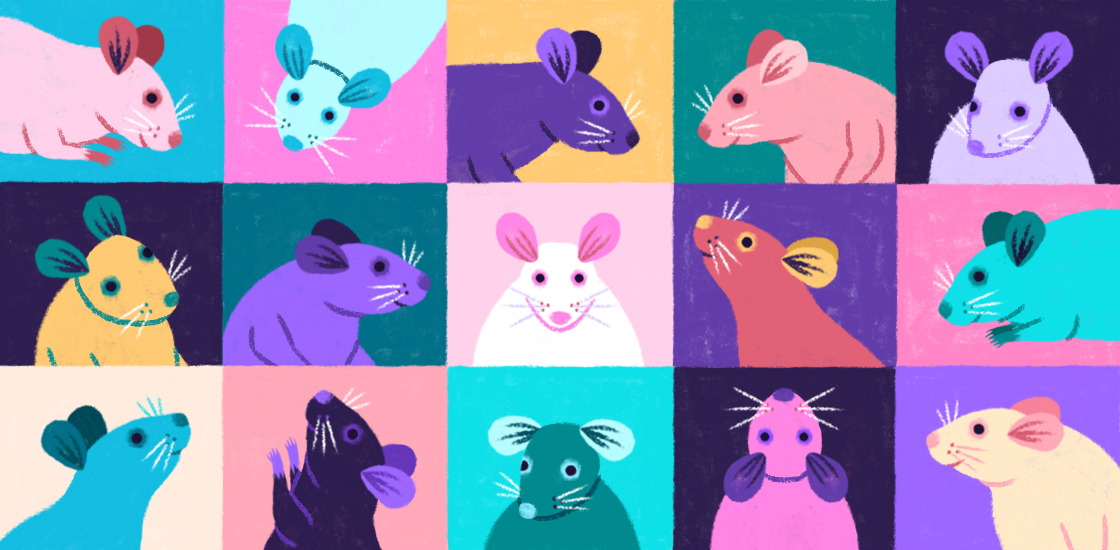THIS ARTICLE IS MORE THAN FIVE YEARS OLD
This article is more than five years old. Autism research — and science in general — is constantly evolving, so older articles may contain information or theories that have been reevaluated since their original publication date.

Much of autism research relies on mouse models — strains that have been genetically altered to display features of the condition. Investigators might, for instance, delete a gene to see if the loss leads to behaviors reminiscent of autism.
Yet the same mutation can produce varying outcomes. At times, the contradiction simply stems from differences in research methods. Other times, though, the animals’ genetic background is at fault: Each strain harbors a unique mix of gene variants, and some of those variants may modify the effects of the mutation.
Background differences in mouse models are akin to the genetic variation we readily acknowledge in people. The variation may account for differences in response to a drug, a high-fat diet or a pathogen.
As researchers develop more and more mouse models, however, contradictory results are proliferating. The potential for genetic background to confound research findings has some investigators wondering whether they should rely on mouse models for autism research at all.
Like many other scientists, I believe that mouse models do have value, as long as investigators take into account the relevant strain’s genetic background. In fact, we may be able to convert the distinct genetic backgrounds of lab mice from a problem to an advantage, exploiting the differences to advance our understanding of autism.
Stable strains:
Mice are a mainstay of biological research in part because breeders can readily produce strains with uniform genetics. A mouse strain is considered inbred after 20 or more consecutive generations of mating between brothers and sisters or between parents and pups.
When all individuals in a strain carry the same variants (as clones and identical twins do), researchers gain confidence that a given experimental manipulation is the prime factor accounting for differences among them.
Different inbred strains differ from one another genetically and in their observable traits. They may vary in appearance, metabolism, immunology, physiology and brain structure, as well as in cognition and levels of anxiety, activity and sociability. Strains can often be distinguished at a glance by coat color, which may be white, black, dilute brown, agouti, chinchilla, gray, black and tan, or piebald. The strain most used in autism research is C57BL/6 (BL stands for black).
Research into three autism-related genes highlights the importance of genetic background in mouse models. All three genes affect the functioning of synapses, the contact points where signals between neurons pass.
One of those genes is FMR1. Certain FMR1 mutations cause fragile X syndrome, a form of intellectual disability that is often accompanied by autism. Mouse models in which FMR1 is rendered nonfunctional can have low sociability, repetitive movements, cognitive difficulties and hyperactivity, depending on the genetic background of the strain1,2.
Certain traits of the mutant mice are constant across strains, indicating that they result from disabling FMR1. But when the genetic manipulation produces effects in only some strains, background genes may be modifying the effects.
For example, researchers identified a mutation in the gene NLGN3 in two brothers with autism. However, when they inserted the mutation into mice, they saw behaviors reminiscent of autism in only some strains3,4,5. In particular, modifier genes in C57BL/6 mice clearly compensated for social difficulties and counteracted the cognitive enhancement seen in two other strains.
By contrast, three inbred strains of mice missing SHANK3, a top autism gene, show similar behaviors, indicating that the strains’ genetic backgrounds exert only modest effects on the behaviors6.
The idea of modifier genes is not new to mouse geneticists, but it has become increasingly relevant as techniques to manipulate genes have become easier and more precise.
Scientists can turn the effects of genetic background on behavior into an opportunity to identify the genes underlying these effects. Those genes could be important modifiers of autism and provide clues to the condition. Finding these genes is likely to be much easier in inbred mice, which are more genetically similar to one another than people are.
Valerie Bolivar is a research scientist and director of the Mouse Behavioral Phenotype Analysis Core at the New York State Department of Health’s Wadsworth Center.

By joining the discussion, you agree to our privacy policy.